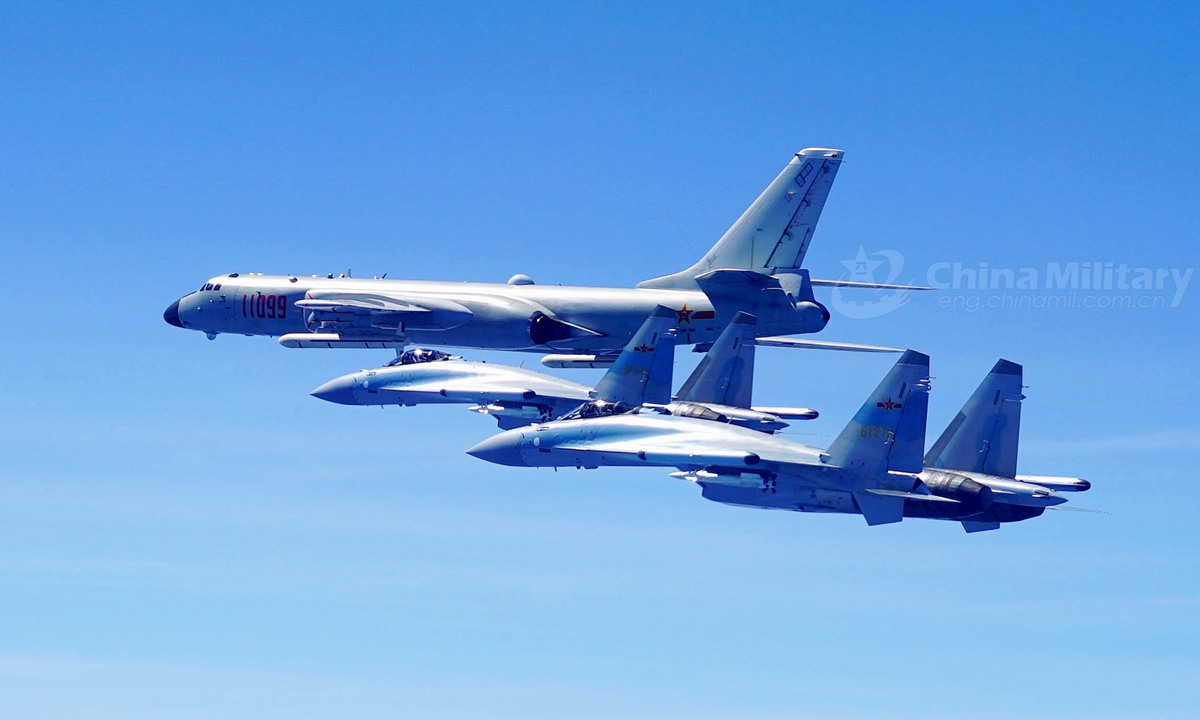
Two Su-35 fighter jets and a H-6K bomber fly in formation on May 11, 2018. The People's Liberation Army (PLA) air force conducted patrol training over China's island of Taiwan on Friday. Su-35 fighter jets flew over the Bashi Channel in formation with the H-6Ks for the first time, which marks a new breakthrough in island patrol patterns, said Shen Jinke, spokesperson for the PLA air force.Photo:China Military
The Biden administration's first arms sales to the island of Taiwan has received US State Department approval, which observers said was "not surprising" as Biden administration is doggedly playing the "Taiwan card" despite the already straining ties.
Citing the Pentagon, Reuters reported Thursday that the deal included the potential sale of 40 155mm M109A6 Medium Self-Propelled Howitzer artillery systems, 1,698 precision guidance kits for munitions, spares, training, ground stations and upgrades for previous generation of howitzers, to the island of Taiwan in a deal worth up to $750 million.
Citing the island's defense authorities, Reuters reported that the howitzers would help its ground forces increase their "capacity for speedy reaction and fire support."
The arms sales were a vicious provocation and in line with US strategy to create trouble for China in the Indo-Pacific. But no matter what weapons and equipment the US sells to the island, it cannot tilt the military capacity gap across the Taiwan Straits, not to mention that the howitzers to be sold this time are outdated weapons and will only become live targets for the Chinese People's Liberation Army (PLA) if a war breaks out in the Straits, experts said.
Self-propelled howitzers cannot play their intended role when the armed forces on the island of Taiwan cannot seize air superiority or control the sea, as they will only become live targets of the PLA if they are deployed into the frontline or coastal positions in a potential war, Wei Dongxu, a Beijing-based military expert, told the Global Times.
While the self-propelled howitzers boast a certain level of mobility, they cannot escape attacks by a combination of multi-role fighter jets, bombers, attack helicopters, rockets and ground troops since they will have no cover, analysts said.
The US Army is already gradually losing its interest in the M109 howitzers, Wei pointed out.
The US is not really helping the island of Taiwan boost its military capability with the arms sales, but is seeing the island as a recycling bin for outdated weapons and equipment, and earning unreasonably high profit from it, while also stirring up more trouble across the Straits, Wei said.
Such a weapon will not be able to change the fact that the PLA holds overwhelming advantages over the military of the island of Taiwan, analysts said.
The Chinese Ministry of Foreign Affairs on Thursday slammed the arms sales, noting China will resolutely take legitimate and necessary counter-measures.
Information of the deal, the first arms sales of the Biden administration, was released as early as April by the Taiwan island. Its proceeding to Congress came a bit later than the Trump administration's first arms sales to Taiwan, which was in June 2017, and was worth $1.4 billion.
Weapons sold this time were less radical and provocative than a 2020 deal approved by the Trump administration, which included 135 precision-guided cruise missiles, mobile light rocket launchers and air reconnaissance pods that can be attached to fighter jets. But Xin Qiang, deputy director of the Center for US Studies at Fudan University in Shanghai, warned of the possibility that the Biden administration would escalate provocations by selling more aggressive weapons as it has no intention to ease the strained China-US relations by being restrained on the Taiwan question.
The US on July 19 landed a civilian version of a military aircraft on Taiwan island, loading and unloading cargo, media reported.
Before that, a C-146A Wolfhound landed at Taipei Songshan Airport on July 15 and stayed for 34 minutes, and three US politicians arrived in Taiwan island on June 6 in a C-17 Globemaster III military transport plane instead of a civilian plane that normally performs such tasks.
Xin noted the US' real goal is to create trouble for Chinese mainland via Taiwan, even if such moves would send the wrong signal to Taiwan secessionists and further strain the already sensitive situation.
Also serving US strategy of stirring up trouble in Indo-Pacific, the US has been mobilizing allies to increase activities around the South China Sea and Taiwan Straits. US navy admiral John Aquilino claimed on Wednesday at the Aspen Security Forum that US military operations came in response to China's actions associated with Hong Kong and Xinjiang.
Aquilino wanted to justify US operations against China by fabricating "a threat," but citing Hong Kong and Xinjiang only demonstrated the nature of the US military — blatant interference in China's internal affairs, Xin noted.




